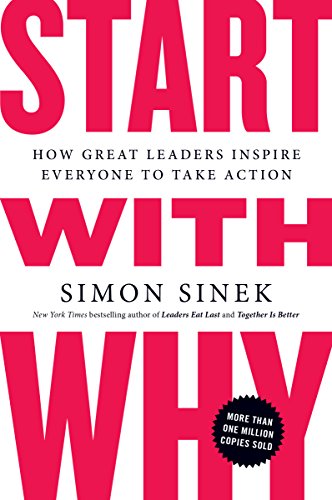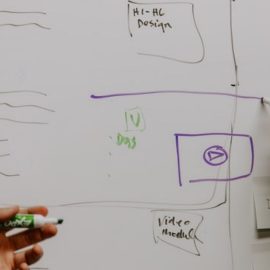

This article is an excerpt from the Shortform summary of "Start With Why" by Simon Sinek. Shortform has the world's best summaries of books you should be reading.
Like this article? Sign up for a free trial here .
What is Simon Sinek’s Golden Circle? How is it useful in creating a successful business?
The Golden Circle is a concept from Simon Sinek’s book Start with Why. The Golden Circle visualizes the structure of an organization and looks like a bullseye target with three rings. The bullseye at the center is the WHY, the next ring out is the HOW, and the largest ring is the WHAT. When making decisions or communicating, you begin at the center with the WHY, then migrate out to the HOW, then finally the WHAT.
We’ll cover what Simon Sinek’s Golden Circle is, how to use it, and why it’s an essential business tool.
Simon Sinek’s Golden Circle Model
Chapter 3 of Start with Why introduces the core concept of The Golden Circle, one of the fundamental concepts of the book. In essence, Simon Sinek’s Golden Circle is the embodiment of how you start with WHY.
Defining Simon Sinek’s Golden Circle
Let’s define the elements of Simon Sinek’s Golden Circle model in reverse order:
- WHAT: this is the product a company sells, the service a company offers, or what a particular employee does. The WHAT is what most companies talk about the most. It’s easy to understand but superficial.
- HOW: this describes HOW the company accomplishes the WHAT. Often, this is considered a company’s “differentiating proprietary process” or “unique value proposition.”
- WHY: this boils down to the motivation behind why companies or people do what they do. This is often a purpose, cause or belief. Why does Microsoft make software, for example? Or why does a particular politician want to run for office? Few people or organizations can explain WHY they do what they do—mainly because it’s the hardest to articulate.
When it comes to communication, people tend to want to work from the outside in because it’s easier to explain your WHAT than it is to explain your WHY. Often, companies even stay at the outside layers, focusing only on the WHAT instead of the HOW or the WHY.
In contrast, all great companies work the Golden Circle in reverse: they start with the bullseye (WHY) and work their way outward.
The Three Principles of Simon Sinek’s Golden Circle Model
The Golden Circle is a powerful tool that helps you run inspirational companies or become a great leader. But The Golden Circle only works if all three elements–the WHY, HOW, and WHAT–are in balance and used in the right order.
Let’s start by talking more about three key principles of Simon Sinek’s Golden Circle.
Golden Circle Element #1: Clarity
Staring with WHY means that leaders need to be able to clearly articulate why they do what they do.
Without a WHY, you have to resort to manipulations to get people to engage with your products or services, which only leads to short-term results.
Leaders who start with WHY get people to follow them willingly instead.
Golden Circle Element #2: Discipline
Discipline kicks in during the HOW phase. (Remember that HOW applies to the values, principles, and operational structures that help you achieve your WHY.)
HOW you work lets you make decisions that support your WHY, like hiring the right people, creating purposeful policies, and finding partners that support your vision.
But in order to do that, you have to have discipline. Counter-intuitively, discovering the WHY is relatively easy – it’s living it, day in and day out, with discipline, that’s the hard part.
Many companies espouse their values in the form of nouns – “Honesty. Customer Service. Innovation.” But effective discipline comes from articulating your values as verbs. Instead of “Integrity,” say “Do the right thing.” Instead of “Innovation,” say “Ask how everyone else is wrong.”
These verbs help people understand how they should act, which in turn, helps them make better decisions in pursuit of the WHY.
Golden Circle Element #3: Consistency
If a WHY is a belief and a HOW is an action, the WHAT is the product.
Authenticity is also important when it comes to sales because it helps people believe in what they’re selling. By being authentic and honest (and appealing to the limbic brain), you can build customer relationships that are based on trust, not manipulation. Consistency and the authenticity that comes from it create long-lasting relationships and long-term success.
Using Simon Sinek’s Golden Circle in the Correct Order
Once you have clarity in WHY, discipline in WHAT, and consistency in HOW, it’s time to make sure you deploy them in the right order.
Remember: great leaders and organizations work the Golden Circle from the inside out, not from the outside in. That means you have to start with WHY, which provides the framework for the HOW and the WHAT.
By keeping each step of Simon Sinek’s Golden Circle in order, you inspire people by connecting with who they are on a much deeper level.
This creates reciprocity. Because you start with WHY, your product (or WHAT) becomes a representation of your beliefs. Customers that share your beliefs will be drawn to your products, which in turn serve as an outward representation of their own WHY, too. Starting with WHY turns people who might say “I think this is the right decision,” into those who say “I know this is the right decision.”
And when you’re able to create a situation where people are able to verbalize their rationale for making a gut decision. This is powerful, and it’s also an example of balance in action.
The Dating Analogy of the Golden Circle
As a thought experiment, consider Tom, a man going on a date. When he sits down, he starts with his WHAT: “I’m a really successful person. I own a BMW and my best friends are all CEOs or models. I’m rich and I can buy you lots of nice things.”
Obviously, Tom sounds obnoxious, the kind of person who wouldn’t get a second date. Surprisingly, companies communicate exactly like this: “Our product has the best features. Our customers are the biggest companies in the world. We’re making a lot of money, and you should buy our product too.”
Now think about Tom starting with WHY: “What gets me out of bed every morning is making an impact on people by solving their problems. It’s the best feeling in the world. I’m also super lucky to get career success doing what I love. I’ve gotten to know lots of interesting people and I’m fortunate to be able to buy nice things.”
Instantly, by starting with WHY, then putting the WHAT after, Tom becomes less obnoxious.
Likewise, companies should message the same way: “We come to work every day to solve our customers’ problems. This is the best feeling in the world. And this is good for business. We’re very successful, and we have the world’s biggest companies as our customers. Our company has never been doing better.”
Clarifying your WHY is well and good. But concretely, how do you achieve your WHY? It comes through building your HOW and your WHAT.
Without a strong HOW, inspirational WHY leaders have big ideas but struggle to execute them. An organization needs to be built to support and execute the WHY.
The Golden Circle Megaphone
By now, you know what The Golden Circle looks like: it’s a bullseye with WHY in the center, HOW in the second ring, and WHAT in the last ring.
But The Golden Circle does more than help you create your message, it amplifies it, too. That’s because The Golden Circle is actually a cone, just like a megaphone. Pretend you’re looking at the Golden Circle from above:
The Golden Circle cone represents the three levels of a company or organization:
1. WHY at the Top
At the top, or point, of the cone is the WHY. This is the smallest layer of the organization which contains the top-level leaders, like the CEO or COO. These leaders provide the vision of the organization by articulating and living out its WHY.
2. HOW in the Middle
The next level of the cone is the larger HOW section. The HOW is comprised of senior executives whose job it is to translate the WHY for other employees. They create systems, rules, and policies that support the company’s WHY. Without great people in the HOW level, a company with a strong WHY can still fail.
3. WHAT at the Bottom
The WHAT level is where the bulk of the company’s employees exist. They’re doing the practical, daily work to bring the company’s products and services to life. But more importantly, these are the people who interact with customers. If they can’t articulate the company’s WHY, then customers won’t understand it, either.
When you start your message at the top and pass it through your organization, it amplifies—just like it would if it passed through a megaphone. It affects people within your organization, and then the organization uses it to amplify the message to the outside world.
———End of Preview———

Like what you just read? Read the rest of the world's best summary of "Start With Why" at Shortform . Learn the book's critical concepts in 20 minutes or less .
Here's what you'll find in our full Start With Why summary :
- What Steve Jobs did right compared to every other business leader
- How to define your organization's WHY
- How to help your organization avoid losing its edge as it succeeds






